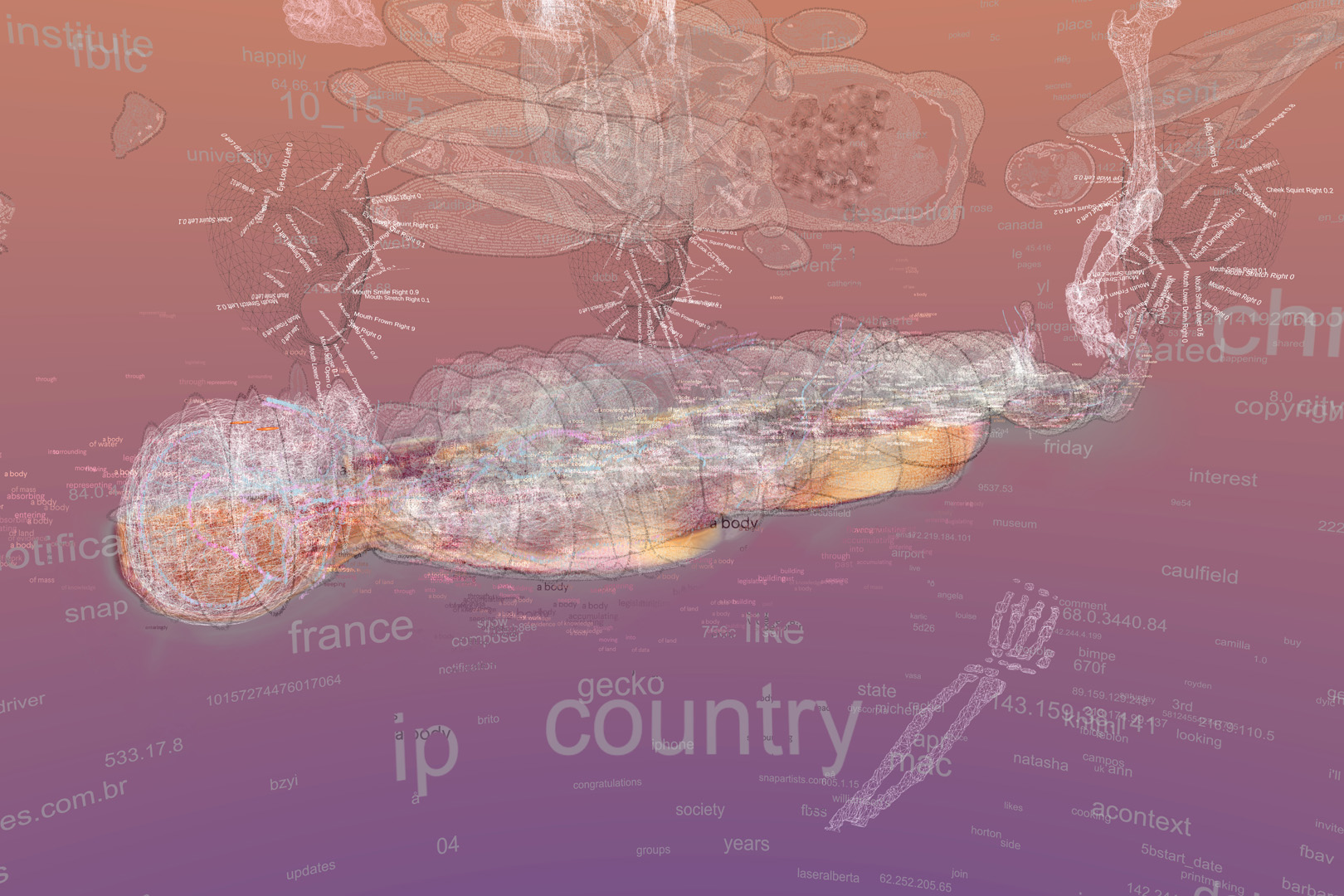“Dissecting My Data Body: How to Know Thyself as a Virtual Reality in the Digital Age” by Oliver, Smallwood, Moore, Carpenter and Cohn
Conference:
Type(s):
Entry Number: 10
Title:
- Dissecting My Data Body: How to Know Thyself as a Virtual Reality in the Digital Age
Presenter(s)/Author(s):
Abstract:
We are constantly being warned that our personal data is vulnerable, that it is being used and abused by artificial intelligence, giant tech corporations and controlling governments. But do we really understand what “our data” consists of and what can be done with and to it? Is it possible to unravel the complex entanglements of data gathering and processing technologies in order to see and understand our data in a meaningful way? My Data Body is a virtual reality (VR) artwork that brings together some of our most personal and sensitive data such as medical scans, social media, biometric and social security data in an attempt to make visible and manipulable our many intersecting data corpuses so that they can be held, inspected, dissected and played with as a way to start understanding and answering these questions. My Data Body has been created as part of the interdisciplinary project Know Thyself as a Virtual Reality (KTVR), a multi-faceted project that explores the ethics and aesthetics of the contemporary “data body”. KTVR brings together researchers across the arts and sciences, to innovate new creatives methodologies, educational resources and ethical guidelines for working artistically with personal data.
References:
Karen Barad. 2007. Meeting the Universe Halfway: Quantum Physics and the Entanglement of Matter and Meaning. Duke University Press, Durham, US.Google Scholar
Zach Blas. 2021. The Doors of Perception: On Nootropics, AI, and Lizards, University of Alberta VADF series, 25 March 2021.Google Scholar
James Bridle. 2018. New Dark Age: Technology and the End of the Future. Verso Books, London, UK.Google Scholar
J.R. Carpenter. 2017. The Gathering Cloud. Uniformbooks, Axminster, UK.Google Scholar
Lisa Cartwright. 1995. Screening the Body: Tracing Medicine’s Visual Culture. University of Minnesota Press, US.Google Scholar
Susan Cox, Sarah Drew, Marilys Guillemin, Catherine Howell, Deborah Warr, Jenny Waycott. 2014. Guidelines for Ethical Visual Research Methods. The University of Melbourne, Melbourne, Australia.Google Scholar
José Van Dijck. 2014. Datafication, Dataism and Dataveillance: Big Data Between Scientific Paradigm and Ideology. Surveillance & Society. 12. 197–208Google Scholar
Roberto Diodato. 2012. Aesthetics of the Virtual. State University of New York Press, New York, US.Google Scholar
C.T. Funkhouser. 2007. Prehistoric Digital Poetry: An Archaeology of Forms 1959-1995. University Alabama Press, US.Google Scholar
Deborah Lupton. 2006. The Quantified Self. Polity, Malden, MA.Google Scholar
Mark Hansen. 2006. Bodies in Code: Interfaces with Digital Media. Routledge, New York, US.Google Scholar
Donna Haraway. 1988. Situated Knowledges: The Science Question in Feminism and the Privilege of Partial Perspective. In Feminist Studies 14, no. 3: 575–99.Google Scholar
Drew Harwell. 2022. Ukraine is scanning faces of dead Russians, then contacting the mothers. The Washington Post. April 15 2022.Google Scholar
Katherine Hayles. 1999. Toward embodied Virtuality. In How we became Posthuman: Virtual bodies in Cybernetics, Literature, and Informatics. University of Chicago Press. Chicago, US.Google Scholar
Tung-Hui Hu. 2015. A Prehistory of the Cloud. MIT Press, US.Google Scholar
Matthew Kugler. 2019. From Identification to Identity Theft: Public Perceptions of Biometric Privacy Harms. U.C. Irvine Law Review, vol. 10, 107–152.Google Scholar
Thomas Mullaney, Benjamin Peters, Mar Hicks and Kavita Philip. 2021. Your Computer is on Fire. MIT, Cambridge, US.Google Scholar
Marilène Oliver, Gary James Joynes, Kumar Punithakumar and Peter Seres. 2021. Deep Connection: Making Virtual Reality Artworks with Medical Scan Data. In 2021 IEEE VIS Arts Program (VISAP), pp. 37-44, DOI: 10.1109/VISAP52981.2021.00011.Google Scholar
Marilène Oliver (Ed.). 2021. Know Thyself as a Virtual Reality Ethics eSymposium proceedings. DOI: https://doi.org/10.7939/r3-kwaj-c351.Google Scholar
Marilène Oliver (Ed.). 2022. Know Thyself as a Virtual Reality. Retrieved May 20, 2022 from https://www.knowthyself.ualberta.ca/Google Scholar
Cynthia Noury, Marianne Cloutier and Marie-Christine Roy. 2018. Toolbox in RCRC : Synthesis of responsible conduct in research-creation issues and proposal of reflective tools. University of Montreál, Quebec, Canada.Google Scholar
Cathy O’Neil. 2016. Weapons of Math Destruction: How Big Data increases Inequality and Threatens Democracy. Crown Books, US.Google Scholar
Karen Parks. 1994. The Criminal and the Saintly Body: Autopsy and Dissection in Renaissance Italy. Renaissance Quarterly, vol 47. 1–33.Google Scholar
Paz Peña and Joana Varon. 2019. Consent to our Data Bodies: Lessons from feminist theories to enforce data protection. Coding Rights. Retrieved from https://codingrights.org/docs/ConsentToOurDataBodies.pdfGoogle Scholar
Julie Posetti, Nabeelah Shabbir, Diana Maynard, Kalina Bontcheva and Nermine Aboulez. 2021. The Chilling: Global trends in online violence against women journalists. UNESCO. Retrieved May 20, 2022 from https://en.unesco.org/publications/thechillingGoogle Scholar
Legacy Russell. 2021. Glitch Feminisms. Verso, London.Google Scholar
Jane Wakefield. 2021. AI emotion-detection software tested on Uyghurs. BBC News, 26 May 2021.Google Scholar




